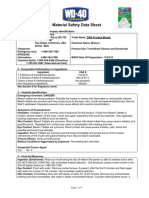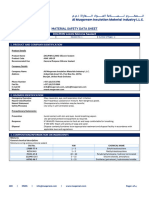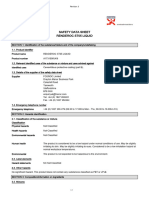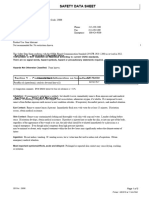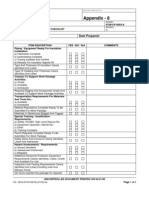MSDS-H1D572C-WB Primer White Outdoor
MSDS-H1D572C-WB Primer White Outdoor
Uploaded by
agung satriaCopyright:
Available Formats
MSDS-H1D572C-WB Primer White Outdoor
MSDS-H1D572C-WB Primer White Outdoor
Uploaded by
agung satriaOriginal Title
Copyright
Available Formats
Share this document
Did you find this document useful?
Is this content inappropriate?
Copyright:
Available Formats
MSDS-H1D572C-WB Primer White Outdoor
MSDS-H1D572C-WB Primer White Outdoor
Uploaded by
agung satriaCopyright:
Available Formats
Material Safety Data Sheet
CARPOLY CHEMICAL GROUP CO., LTD. DATE ISSUED:Jun.1st,2009
DATE REVISED :March.15th,2021 PRODUCT:H1D572C
1. Chemicals and Company logo
Trade name: Water-based Paint
Chemicals Chinese name:水性白底漆 H1D572C
Chemicals English name: Water-based primer white outdoor H1D572C
Application: Furniture applications.
Company:
Carpoly Chemical Group Co., Ltd
Jinxi Industrial District, Tangxia Town, Pengjiang Area, Jiangmen, Guangdong, China
TEL:+86 750 3578771 FAX:+86 750 3578771
Emergency telephone: +86 750 3578000
2. Hazards Summarizing
Hazard Pictograms:
Hazard Statesments: Causes eye irritation.
Causes skin allergy.
May cause allergy, asthma and dyspnea if inhaled.
May cause respiratory irritation.
3. Composition/Information on Ingredients
Type of product: Mixture
Chemicals name: Water-based Primer White H1D562
Hazardous components Concentration CAS NO.
Polyurethane acrylic emulsion 70-80% 51852-81-4
Dipropylene glycol mono butyl ether 2-5% 29911-28-2
Thickener 0-1% 526-95-4
Flatting agent 0-1% 128192-17-6
Antiseptic 0-0.1% 55965-84-9
52-51-7
Water 0-25% 7732-18-5
4. First Aid Measures
General: In all cases of doubt, or when symptoms persist, seek medical attention. Never give anything by mouth to an
unconscious person. If unconscious, place in recovery position and seek medical advice.
Eye Contact: Open the eyes and immediately flush eyes with running water for 5-10 minutes, keeping eyelids open. Seek
immediate medical attention.
Inhalation: Remove to fresh air. Keep person warm and at rest. If symptoms persist, consult the physician.
Skin contact: Remove contaminated clothing and shoes. Wash skin thoroughly with soap and water or use recognized skin
cleanser. Do NOT use solvents or thinners.
Ingestion: Keep person warm and at rest, If swallowed, seek medical advice immediately.
Do NOT induce vomiting. if vomit, keep the head lower to reduce the risk of the contents in stomach into the lung.
Notes for physician: No action shall be taken involving any personal risk or without suitable training. No Specific antidote. Treat
the patienst based on their symptoms and clinical conditions.
5. Fire-Fighting Measures
Extinguishing Media: Use water mist or foam, dry chemical, or CO2 to extinguish fire. Cool fire exposed container with water.
Fire Extinguishing Procedure: Disperse the crowds, unnecessary access is forbidded.Soak the burning product thoroughly with
water to cool and prevent reignition. If the product is molten,do not use the water steram to extinguish fire directly .Use water mist
or foam.Cool the surroundings with water to localize the fire zone.
Unsuitable Fire Extinguishing Method: Do not extinguish fire by spraying water or pouring water, otherwise the fire will spread.
Special Fire Extinguishing Procedure: Unknown
Special Protective Equipment For Firefighters: Firefighters should wear positive pressure self-contained breathing
apparatus(SCBA) and full protective clothing for fires in areas where chemicals are used or stored.If no equipment or protective
equipment is not available,extinguish fire in the protected area or at a safe distance.
6. Accidental Release Measures
Page 1/3 PU paint MSDS
Material Safety Data Sheet
Precautionary Measure: Avoid contact with skin and eyes. Avoid inhaling the volatiles. Follow the safety instructions described in
Part 7 and Part 8. Distance the irrelevant from the fire scene. No smoking.
Protective Equipment: Wear positive pressure self-contained breathing apparatus(SCBA) and full protective clothing for fires (eg.
fireproof helmet, clothing,pants, boots and gloves).
Emergency Response Procedure: Absorb liquid with sand and soil, collect it in an appropriate labeled container.
Environmental Protection Measures: Do not drain into soil, ditch, sewer, drain and underground water.
Spill Solution: Prevent liquid from entering sewers, drain and basement. Absorb liquid with the substance without reacting with
each other. Collect the spills into suitable dustbin.
7. Handling And Storage
Handling: Avoid contact with eyes, skin and clothing. Avoid inhaling the volatiles. No intake, drink or inhalation in the place where
the product is handled. Keep the product away from strong acids, strong alkalis and oxidizing agents.
Storage: Keep container tightly closed .
Keep away from: oxidizing agents, strong alkalis, strong acids.
Store in a dry, cool and well-ventilated area.
Additional information on storage conditions
Package: Do not use compressed air when emptying containers. Restuffed substance must be the same as orginals.
8. Exposure controls / Personal Protection
Admissible Concentration: N.A.
Exposure Control: Provide extract ventilator or other engineering control equipment. Keep gas concentration lower than
occupational exposure limit. Make sure the eye lotion and safe shower close to workplace.
Sanitary Measure: Wash hands, forearm and face after work or before food intaking, smoking and toilet. Always wash skin
exposured to the product immediately. Use suitable skin cleanser.
Respiratory Protection: If exceeding exposure limit is possible, respiratory protection is needed. If no requirement and guideline of
exposure limit, but respiration irritate or discomfort occurs, and the operation is expected to cause the danger, respiratory
protective equipment is needed.No respiratory protection is required,unless the product is heated or sprayed. Good air purifying
respirator: organic steam toner cartridge with special prefilter.
Hand Protection: Wear suitable protective gloves.Preferred material of glove: polyvinyl chloride, neoprene,Nitrile diene rubber and
butadiene rubber.Note:when choosing special gloves and confirming time limit for gloves in the workplace, all related factors in
workplace should be considered.These factors include but are not limited to: other chemicals handled, physical
requirements(cutting, sensitivity and thermal protection), potential impact on glove, as well as product description and instructions
provided by the glove supplier.
Eye Protection: If the product is likely to splash, wear protective glasses.
Skin and Body Protection:Wear suitable protective covers. Wear face mask, boots, apron or full-body suit according to the
situation.
9. Physical And Chemical Properties
Appearance: Liquid
Boiling Point(℃): 100 ℃
Relative Density: 1.060g/cm3 (Water=1)
Flash Point(℃): Incombustible Matter
Ignition Point(℃):Non-flammable
Solubility in Water: Water reducible
10. Stability And Reactivity
Stability: Thermal stability in special temperature and pressure
Conditions To Avoid: Avoid heat, sparks, flames and other sources of ignition.
Incompatible substances: Avoid contact with strong acid, strong alkali and strong oxidizing agents.
Dangerous Catabolite: /
Reactivity: Slight reaction with oxidants.
Harmful Ingredients Produced by Heating: CO, CO2
Page 2/3 PU paint MSDS
Material Safety Data Sheet
11. Toxicological Information
Ingestion: Single oral, low toxicity. If occasionally swallowing a small amount or operating under normal conditions, no harm will
occur. Large quantities of swallowing can be harmful.
Inhalation: Single long excessive inhalation (hours) will not cause adverse impacts.If inhalating a small amount of the steam and
mist, respiratory system will be irritated, especially in a small and poorly ventilated room.
Acute Toxicity: LD50 5440mg/kg (Rat).
Eye Irritation or Corrosion: Slight irritation (Rabbit). In case of contact with eyes, the irritation and temporary injuries for eyes will
occur.
Respiratory or Skin Allergy: Repeated or prolonged exposure to this product may result in the removal of oils on the skin surface.
Skin allergy will not occur by skin contact and absorption.
Reproductive Toxicity: No evidence that it is harmful to reproductive system.
12. Ecological Information
Ecotoxicity: No test data available.
Persistence And Degradability: No test data available.
Potential bioaccumulation: No test data available.
Transference In The Soil: No test data available.
13. Disposal Information
Waste Disposal: Recycle or disposed under current regulations by qualified waster disposal agent.
Contaminated Containers and Package: Recycle or disposed under current regulations by qualified waster disposal agent.
Methods of Disposal: Waste should not be disposed of untreated to any ditch and sewer. Transportation,storage, using and
disposal of the product should at all times comply with the requirements of all authorities with jurisdiction.
14. Transport Informationl
Dangerous Goods Code: /
UN Number: /
Packaging Marks: /
Packing Group: /
Marine Pollutant:/
Others: This product is a general chemical, and has no special transporting requirements
15. Regulatory Information
Environmental protection law of the People's Republic of China
Regulations on the safety management of hazardous chemicals(published in December 1, 2011)
Implementing rules for regulations on the safety management of hazardous chemicals(1992)
Safe use of chemicals in the workplace
GB/T 13690-2009:General rule for classification and hazard communication of chemicals
GB/T 15603-1995:Rule for storage of hazardous chemicals
GB/T 190-2009: Packing symbol of dangerous goods
GB/T 191-2008: Packaging-Pictorial marking for handling of goods
GB/T 15098-2008: The principle of classification of transport packaging groups of dangerous goods
GB/T 12463-2009: General specifications for transport package of dangerous goods
GB/T 12268-2005: List of dangerous goods
GB/T 6944-2005: Classification and code of dangerous goods
GB/T 15258-2009: General rule for preparation of precautionary label for chemicals
GB/T16483-2008: Safety data sheet for chemical products-content and order of sections
GB/T 18218-2009: Identification of major hazard installations for hazardous chemicals
GBZ 2.1-2007: Occupational exposure limits for hazardous agents in the
Globally harmonized system of classification and labelling of chemicals(GHS)
16. Other Information
The information provided in this Safety Data Sheet is correct to the best of our knowledge, information and belief at the date of its
publication. The information given is designed only as a guidance for safe handling, use, processing, storage, transportation,
disposal and release and is not to be considered a warranty or quality specification. The information relates only to the specific
materials designated. Refer to individual product safety Data sheets when using more than one product in combination with
another.
Page 3/3 PU paint MSDS
You might also like
- PharmacologyDocument33 pagesPharmacologyFreeNursingNotes89% (72)
- MSDS Sodium Hydrosulfite 90% Ex GuangdiDocument7 pagesMSDS Sodium Hydrosulfite 90% Ex GuangdidianNo ratings yet
- Ningxia MSDS For Ascorbic AcidDocument4 pagesNingxia MSDS For Ascorbic AcidSepti Liana100% (1)
- Sparkle - Safety Data Sheet (SDS) - 2021 EngDocument4 pagesSparkle - Safety Data Sheet (SDS) - 2021 EngSophie TranNo ratings yet
- Plaintiff's Response To Demand For ParticularsDocument4 pagesPlaintiff's Response To Demand For ParticularsCanadian Society for the Advancement of Science in Public PolicyNo ratings yet
- Presidential Decree 1096 The National Building Code of The Philippines BDocument46 pagesPresidential Decree 1096 The National Building Code of The Philippines Bjohn michael alondeNo ratings yet
- The Nuts and Bolts of Transformational Coaching?: Jean Côté, PHD Queen'S University @jeancote46 Email: Jc46@Queensu - CaDocument48 pagesThe Nuts and Bolts of Transformational Coaching?: Jean Côté, PHD Queen'S University @jeancote46 Email: Jc46@Queensu - CaTrần Gia Hải100% (2)
- Msds h1d502 Ws WB Teaks BrownDocument4 pagesMsds h1d502 Ws WB Teaks BrownAjiWidyartaNo ratings yet
- Dextone MSDSDocument4 pagesDextone MSDSMario Mandala PutraNo ratings yet
- Hfutc5kubDocument4 pagesHfutc5kubNandar Min HtetNo ratings yet
- Ptei Estocure P - Sds - 190405Document5 pagesPtei Estocure P - Sds - 190405Denis nataliaNo ratings yet
- Safety Data Sheet: 1. Identification of The Substance/preparation and of The Company/undertakingDocument4 pagesSafety Data Sheet: 1. Identification of The Substance/preparation and of The Company/undertakingBNo ratings yet
- MSDS GdaDocument7 pagesMSDS GdagamsiwNo ratings yet
- Safety Data Sheet: Tokyo Chemical Industry Co., LTDDocument4 pagesSafety Data Sheet: Tokyo Chemical Industry Co., LTDWinNo ratings yet
- Resina MEGAPOXY HICB-Part-B-Version-2.1 - Ficha Segurança - ENGDocument6 pagesResina MEGAPOXY HICB-Part-B-Version-2.1 - Ficha Segurança - ENGfernando.luis.mariaNo ratings yet
- MSDS - Dolphin Carb & Choke CleanerDocument5 pagesMSDS - Dolphin Carb & Choke CleaneradminNo ratings yet
- Annex C - Safety Data Sheet - Part-BDocument6 pagesAnnex C - Safety Data Sheet - Part-BpoonchingyeeNo ratings yet
- Native Green SDS Bio+ Liquid Manual Dish DeterDocument5 pagesNative Green SDS Bio+ Liquid Manual Dish Deternavoda.ranvelNo ratings yet
- Material Safety Data Sheet (MSDS) - 2000 FlushesDocument4 pagesMaterial Safety Data Sheet (MSDS) - 2000 Flushestruongthuy2811No ratings yet
- Material Safety Data SheetDocument9 pagesMaterial Safety Data SheetAmarjit SinghNo ratings yet
- MSDS Wilgard C21Document5 pagesMSDS Wilgard C21muhammad46sidiqNo ratings yet
- MSDS UV InkDocument4 pagesMSDS UV Inknorbertscribd0% (1)
- Msds-Adhesive RL-1955 M21Document3 pagesMsds-Adhesive RL-1955 M21gilang gilongNo ratings yet
- SDS-Flake Phthalic Anhydride of Contitnental Petrochemicals (Thailand) Co.,Ltd.Document6 pagesSDS-Flake Phthalic Anhydride of Contitnental Petrochemicals (Thailand) Co.,Ltd.Muslim NasirNo ratings yet
- Material Safety Data Sheet-AcrobatDocument8 pagesMaterial Safety Data Sheet-AcrobatMash HudaNo ratings yet
- MSDS for Maxtreat 635 (1)Document5 pagesMSDS for Maxtreat 635 (1)engineeringnorth.tvmNo ratings yet
- Safety Data Sheet: Tokyo Chemical Industry Co., LTDDocument4 pagesSafety Data Sheet: Tokyo Chemical Industry Co., LTDPrabhashi RanasingheNo ratings yet
- M105564Document4 pagesM105564amine.essaki8No ratings yet
- MSDS UnitizerDocument5 pagesMSDS UnitizerDendi Pradeep ReddyNo ratings yet
- Bleach Disinfectant CleanerDocument8 pagesBleach Disinfectant Cleanergbaboolall1No ratings yet
- RustGo MSDSDocument6 pagesRustGo MSDSFitrianis NovitaNo ratings yet
- MSDS Desoximetasone Ointment 0.25 TeligentDocument4 pagesMSDS Desoximetasone Ointment 0.25 TeligentIntan AisyahNo ratings yet
- Nitoproof 600Document3 pagesNitoproof 600sanjay kumarNo ratings yet
- Dolphin 140 1200g MsdsDocument4 pagesDolphin 140 1200g Msdsdeekshith212000No ratings yet
- Ami 150 GP 1200G MSDSDocument4 pagesAmi 150 GP 1200G MSDSalsultan.shaamhosp.eng1No ratings yet
- 0041 Q6boc5kubDocument5 pages0041 Q6boc5kubNandar Min HtetNo ratings yet
- DOLPHIN Duct - MSDSDocument4 pagesDOLPHIN Duct - MSDSanwarNo ratings yet
- Plant Prod 10-52-10 SdsDocument6 pagesPlant Prod 10-52-10 SdsYing “Tomato Grower” YangNo ratings yet
- MSDS ABS GF 20% V0 XindaDocument5 pagesMSDS ABS GF 20% V0 Xindaanisa novita sariNo ratings yet
- Grease Bearing SKFDocument6 pagesGrease Bearing SKFNNNo ratings yet
- Pure Guard High Temp EP Grease US - SDS Rev 3Document8 pagesPure Guard High Temp EP Grease US - SDS Rev 3VARGASNo ratings yet
- 2 msds-POLYESTER LEVELLING AGENT (RAP RM)Document9 pages2 msds-POLYESTER LEVELLING AGENT (RAP RM)saddamNo ratings yet
- 15.20 Bio Clean SafetyDataSheetDocument4 pages15.20 Bio Clean SafetyDataSheetFrancisco GonzalezNo ratings yet
- M Aterial Safety Data Sheet: 1. Identification of The Material and SupplierDocument4 pagesM Aterial Safety Data Sheet: 1. Identification of The Material and SupplierDendi Pradeep ReddyNo ratings yet
- MSDS RBD PoDocument3 pagesMSDS RBD PoAnggunNo ratings yet
- MSDS - SLES PrakashDocument11 pagesMSDS - SLES PrakashAd NaturecertNo ratings yet
- Shine-On 22Document3 pagesShine-On 22I Gusti PradanaNo ratings yet
- Renderoc ST05 Liquid SDSDocument16 pagesRenderoc ST05 Liquid SDSwrichardsNo ratings yet
- MSDSDocument7 pagesMSDSShahid IqbalNo ratings yet
- MSDS AEO 7 Rev.Document14 pagesMSDS AEO 7 Rev.Yousry ElgazarNo ratings yet
- LCo PureTungOil SDS 220921Document9 pagesLCo PureTungOil SDS 220921swerNo ratings yet
- MSDS of BKC 80-UN3265Document6 pagesMSDS of BKC 80-UN3265Vinicius100% (1)
- 7266 Fq1hc5kubDocument5 pages7266 Fq1hc5kubNandar Min HtetNo ratings yet
- Safety Data Sheet: 1 Identification of The Substance/preparation and of The Company/undertakingDocument9 pagesSafety Data Sheet: 1 Identification of The Substance/preparation and of The Company/undertakingAndres CruzNo ratings yet
- General Purpose BleachDocument5 pagesGeneral Purpose BleachAnthoney MooreNo ratings yet
- Dolphin 530 WS MSDSDocument4 pagesDolphin 530 WS MSDSRajneesh SainiNo ratings yet
- DOLPHIN Acryseal Acrylic - MSDSDocument4 pagesDOLPHIN Acryseal Acrylic - MSDSahmadbardawilkamalNo ratings yet
- Unitop-Fft-40 MSDSDocument4 pagesUnitop-Fft-40 MSDSfeminpatelNo ratings yet
- Desco Valve CutDocument5 pagesDesco Valve Cutpemping1No ratings yet
- Safety Data Sheet: Section 1: Identification of The Product and CompanyDocument7 pagesSafety Data Sheet: Section 1: Identification of The Product and CompanyFuckyouNo ratings yet
- Scale Inhibitor-MSDSDocument6 pagesScale Inhibitor-MSDSHussein Adnan FneishNo ratings yet
- Ep Lube 95 ZurnoilDocument5 pagesEp Lube 95 ZurnoilklopezibarguenNo ratings yet
- Optigal’s Q & A for the CLRE: Contact Lens Registry Exam Questions Basic Certification - NCLEFrom EverandOptigal’s Q & A for the CLRE: Contact Lens Registry Exam Questions Basic Certification - NCLENo ratings yet
- Rex-6001a C0Document1 pageRex-6001a C0agung satriaNo ratings yet
- 2016 Forest Forum RusiaDocument21 pages2016 Forest Forum Rusiaagung satriaNo ratings yet
- Connection Methods For Timber EngineeringDocument45 pagesConnection Methods For Timber Engineeringagung satriaNo ratings yet
- MSDS SayerlackDocument13 pagesMSDS Sayerlackagung satriaNo ratings yet
- Overview Status Global National Lead Paint LawsDocument10 pagesOverview Status Global National Lead Paint Lawsagung satriaNo ratings yet
- MSDS ACQUA FILLER 100 Light TeakDocument6 pagesMSDS ACQUA FILLER 100 Light Teakagung satriaNo ratings yet
- Green Triangle Forest Industry ProspectsDocument36 pagesGreen Triangle Forest Industry Prospectsagung satriaNo ratings yet
- Wood Color Plus Wood Color PlusDocument16 pagesWood Color Plus Wood Color Plusagung satriaNo ratings yet
- Sandwich Panels: Installation GuideDocument70 pagesSandwich Panels: Installation Guideagung satriaNo ratings yet
- UNECE TIMBER FORECAST - September 2016 UK Timber Market StatementDocument33 pagesUNECE TIMBER FORECAST - September 2016 UK Timber Market Statementagung satriaNo ratings yet
- Consumption of Plywood and Sawn Timber For Concrete Formwork in The Chinese Construction IndustryDocument9 pagesConsumption of Plywood and Sawn Timber For Concrete Formwork in The Chinese Construction Industryagung satriaNo ratings yet
- Borobudur Temple: - Kelompok 6Document6 pagesBorobudur Temple: - Kelompok 6agung satriaNo ratings yet
- Creating New Foods CH 4Document25 pagesCreating New Foods CH 4agung satriaNo ratings yet
- Environment Impact Assessment (Eia)Document9 pagesEnvironment Impact Assessment (Eia)DYCENo ratings yet
- Parents ConsentDocument3 pagesParents ConsentIRENE REFORMANo ratings yet
- Module 10Document3 pagesModule 10eguasglobalresourcesltdNo ratings yet
- Insulation InstallationDocument2 pagesInsulation InstallationmayasolaniNo ratings yet
- Benefits of SMART Therapy For Asthma ManagementDocument4 pagesBenefits of SMART Therapy For Asthma ManagementREDANo ratings yet
- Chandigarh NGO List Who Provide Vocational TrainingDocument12 pagesChandigarh NGO List Who Provide Vocational TrainingPankaj MauryaNo ratings yet
- 1 PBDocument3 pages1 PBHaola andaniNo ratings yet
- Dynalog File Viewer Reference GuideDocument47 pagesDynalog File Viewer Reference GuideCargo100% (1)
- Akshay G Subramoniam 2150504 - Research Paper Cia 3Document6 pagesAkshay G Subramoniam 2150504 - Research Paper Cia 3akshauyNo ratings yet
- Relations of Husbands' and Wives' Dysphoria To Marital ConflictDocument14 pagesRelations of Husbands' and Wives' Dysphoria To Marital ConflictPhúc TokyoNo ratings yet
- Prospectus Mbbs KMC 2016.PDF-1206356120Document16 pagesProspectus Mbbs KMC 2016.PDF-1206356120pradeepNo ratings yet
- F. Systemic PathologyDocument25 pagesF. Systemic PathologyMagda TvildianiNo ratings yet
- Standard - Guidelines For Healthcentre in Nepal PDFDocument58 pagesStandard - Guidelines For Healthcentre in Nepal PDFSANDESH100% (3)
- 1008 Issue of The Daily JournalDocument32 pages1008 Issue of The Daily JournalSan Mateo Daily JournalNo ratings yet
- Essentials of Abnormal Psychology 7th Edition Durand Test BankDocument30 pagesEssentials of Abnormal Psychology 7th Edition Durand Test Banknhiamandat4uvr100% (33)
- Adolescents: Problems and SolutionsDocument12 pagesAdolescents: Problems and SolutionsIRMA SAFRIANI75% (4)
- List of Hospitals in India Sorted by Hospital Name PDFDocument334 pagesList of Hospitals in India Sorted by Hospital Name PDFmantoo kumarNo ratings yet
- BIOLOGY PaperDocument2 pagesBIOLOGY PaperParth PatilNo ratings yet
- Music, Arts, Physical Education and Health Department Grade 9 Xevera, Calibutbut, Bacolor, PampangaDocument13 pagesMusic, Arts, Physical Education and Health Department Grade 9 Xevera, Calibutbut, Bacolor, PampangaJulie Yoj DeocarezaNo ratings yet
- Sexual Response CycleDocument7 pagesSexual Response CycleHana-Lou TaquiquiNo ratings yet
- EML-Leading-Self-Reflections-WorksheetDocument9 pagesEML-Leading-Self-Reflections-WorksheettonyjesudasNo ratings yet
- Latest CVDocument5 pagesLatest CVNahom Endalegeta100% (1)
- Antimicrobial Activities and Phytochemical Composition of Extracts of Ficus Species: An Over ViewDocument13 pagesAntimicrobial Activities and Phytochemical Composition of Extracts of Ficus Species: An Over ViewHasana UlfaNo ratings yet
- Handleiding CS CSX Serie Enkeltraps CentrifigaalpompDocument52 pagesHandleiding CS CSX Serie Enkeltraps CentrifigaalpompPingu3No ratings yet
- Filtro Bacteriologico Puritan BennetDocument24 pagesFiltro Bacteriologico Puritan BennetRonald David ReyesNo ratings yet
- Think StrongDocument81 pagesThink Strongtom100% (2)


















